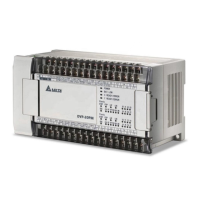3 Devices
4. The setting value of a 32-bit high-speed counter can be a constant preceded by K, or the value
stored in two consecutive data registers. (The special data registers D1000~D2999 can not be
used.) A setting value can be a positive value, or a negative value.
5. If a power cut occurs when a general counter in a DVP-20PM series motion controller counts, the
present value of the counter will be cleared. If a power cut occurs when a latching counter counts,
the present value of the counter and the state of the contact of the counter will be retained, and the
latching counter will not continue counting until power is restored.
6. If a counter counts up from the present value 2,147,483,647, the next value following
2,147,483,647 will be -2,147,483,648. If a counter counts down from the present value
-2,147,483,648, the next value following -2,147,483,648 will be 2,147,483,647.
3.8 Registers
Registers are classified according to their characters. There are four types of registers.
1. General register: If the STOP/RUN switch on a DVP-20PM series motion controller is turned
from the STOP position to the RUN position, or a DVP-20PM series motion
controller is disconnected, the values in the general registers will become 0. If
M1033 in a DVP-20PM series motion controller is turned ON, the values in
the general registers will be retained after the STOP/RUN switch on the
DVP-20PM series motion controller is turned from the RUN position to the
STOP position, and will become 0 after the module is disconnected.
2. Latching register: If a module is disconnected, the values in the latching registers will be
retained.
If users want to clear the value in a latching register, they can use the
instruction RST or ZRST.
3. Special data register: Every special data register has its definition and purposes. System states,
error messages, and states monitored are stored in special data registers.
Please refer to section 3.10 and section 3.11 for more information about
special auxiliary relays and special data registers.
4. Index register (V)/(Z): V devices are 16-bit registers, and Z devices are 32-bit registers. There are 8
V devices (V0~V7), and 8 Z devices (Z0~Z7) in a DVP-20PM series motion
controller.
3.8.1 Data Registers
The value in a data register is a 16-bit value. The highest bit
in a 16-bit data register represents an
algebraic sign. The value stored in a data register must be in the range of -32,768 to +32,767. Two 16-bit
data registers can be combined into one 32-bit data register (D+1, D). The highest bit in a 32-bit data
register represents an algebraic sign. The value stored in a 32-bit data register must be in the range of
-2,147,483,648 to +2,147,483,647.
General data register
D0~D199 (200 general data registers in total)
Users can change them to latching devices by setting
parameters.
Latching data register
D200~D999 and D3000~D9999 (7,800 latching data
register in total)
Users can change them to non-latching devices by
setting parameters.
Data register
(D)
Special data register
D1000~D2999 (2,000 special data registers in total)
Some of them are latching devices.
10,000 data
registers in
total
DVP-20PM Application Manual
3-13

